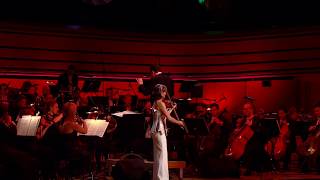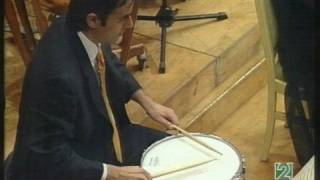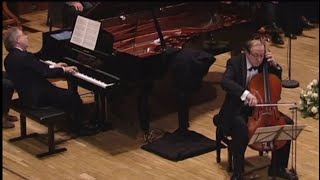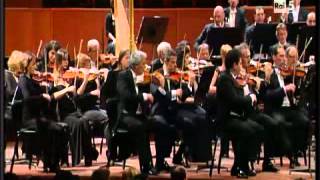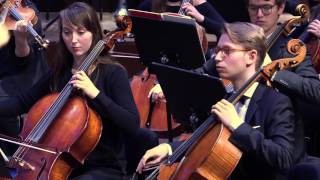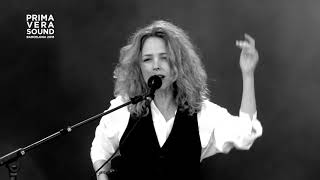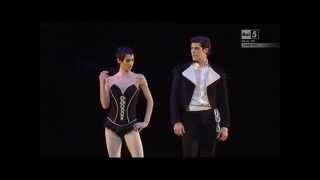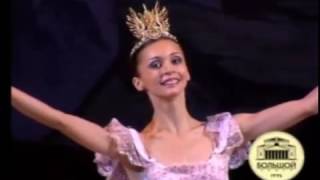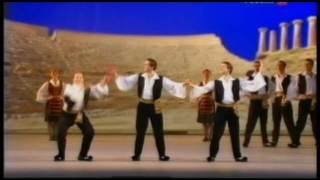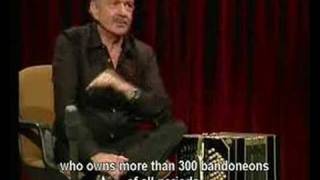Recommended music videos for initiation to classical music
Claudio Monteverdi (1567-1643), was an Italian composer, viola player, singer, choir director and priest. He composed both secular and sacred music and marked the transition between the polyphonic and madrigal tradition of the 16th century and the birth of lyrical drama and opera in the 17th century . He is a crucial figure in the transition between Renaissance and Baroque music. Born in Cremona , where he carried out his first musical studies and compositions, at the age of 16 he published his first works. He spent his career first at the court of Mantua and then, until his death, in the Republic of Venice .
The madrigal is a composition of three to six voices over a secular text, often in Italian. It had its peak in the Renaissance and early Baroque . Musically it recognizes origins in the frottola , it has lyrics in the Italian language with secular themes, popular character and contrapuntal harmony; composed mostly for a cappella voices and in some cases with instruments doubling the vocal parts.
Monteverdi's Madrigals occupy a prominent place in the history of music, mainly choral music, and represent the culmination of the madrigalesque genre. Throughout these books it is possible to appreciate the evolution of Monteverdi 's music, from the polyphonic style of Renaissance music to the use of the accompanied monody characteristic of the Baroque . The first four books of madrigals, composed for five a cappella voices, are situated within the Prima pratica, the traditional polyphonic style, although Monteverdi uses increasingly innovative harmonic language, with bolder dissonances as the series progresses.
The Fifth Book of Madrigals was published in 1605 dedicated to his patron, Duke Vicenzo Gonzaga of Mantua and constitutes the turning point towards the Seconda pratica , where music is subordinated to the emotional expression of the poetic text, in line with the nascent opera and the principles of Florentine humanism, with more varied combinations of voices and solo parts, and with the instrumental accompaniment of the basso continuo, where "words are owners of harmony, not slaves." On the other hand, the traditional five-voice madrigal is transformed in this book into a madrigale concertato , introducing the instrumental accompaniment of the basso continuo.
I. Cruda Amarilli (00:00) II. O Mirtillo, Mirtill'anima Mia (03:01) III. It was L'anima Mia (05:45) IV. Ecco, Silvio, Colei (09:21) V. Ch'io T'ami (24:43) VI. Che Dar Più Vi Poss'io? (33:16) VII. M'è Più Dolce Il Penar Per Amarilli (36:37) VIII. There, Eat A Vague Sun Cortese Giro (40:18) IX. Troppo Ben Può Questo Tiranno Amore! (45:13) X. Love, Be Giusto Sei (48:52) XI. T'amo, Mia Vita! (52:41) XII. E Così, A Poco (55:42) XIII. Questi Vaghi Concenti (59:08)
Franz Liszt (1811-1886) was a brilliant Hungarian pianist and composer, whose works have endured over the years; works for solo or concert piano, as well as orchestral works, among which his symphonic poems should be highlighted, the musical form of which he is the progenitor. Liszt 's father, an amateur musician, gave him his first piano lesson at the age of seven. In October and November 1820, at the age of nine, he appeared in concerts in Sopron and Bratislava . His father arranged for Franz to be presented to the Court of the House of Esterházy as a child prodigy. He was famous throughout Europe during the 19th century ; His contemporaries claimed that he was the most technically advanced pianist of his time and the greatest of all time.
Hungarian Rhapsody No. 2 is part of Lizt 's nineteen Hungarian Rhapsodies . It offers the pianist the opportunity to showcase his virtuosity while greatly engaging the audience. The work consists of two different parts: the Lassan and the Friska (from Hungarian: lassú - slow; friss - fresh, fast). It is written in C sharp minor and is dedicated to Count Ladislas Teleky ("au Comte Ladislas Teleky"). It was composed in 1847 and first published as a solo piano piece in 1851. This rhapsody has been used in cartoons, various films, and has served as the basis for several popular songs. Today we offer it in a version for violin and orchestra with the Hungarian violinist Katica Illény i, accompanied by the Győr Philharmonic Orchestra, conducted by István Silló.
Jesús Guridi (1886-1961) was born in Vitoria-Gazteiz into a musical family. After the family moved to Madrid , Guridi entered the Conservatory ; However, the economy did not go well for the parents, so they moved to Bilbao , where thanks to the patron, the Count of Zubiría , they were able to move to Paris and enter the Schola Cantorum to study piano, organ, counterpoint and composition. After finishing his studies, he went through Belgium , Cologne and Munich to delve deeper into them. Returning to Bilbao , at the age of 21, he took charge, as director, of the Bilbao Choral Society , a job that he combined with that of organist at the Basilica (now Cathedral) of Santiago . In 1939 he returned to Madrid , as director of the Conservatory , where he died at the age of 75.
El Caserío is an early 20th century zarzuela written by Federico Romero and Guillermo Fernández-Shaw , with music by Jesús Guridi . It premiered at the Teatro de la Zarzuela in Madrid on November 11, 1926. El Caserío , a lyrical comedy in three acts with much of its music inspired by Basque folklore, is one of Guridi 's most important compositions; of a traditional character, in it we are exposed to the daily life of an imaginary peasant village, Arrigorri , with its typical stereotyped characters: the priest, the mayor, the secretary, the rich Indian, the tavern keeper... Today we offer its Prelude conducted by the illustrious Toresan teacher Jesús López Cobos .
Yann Tiersen (1970), is a multifaceted French composer, who, among other music, has composed the soundtrack of the films Amélie, Good Bye, Lenin! and Tabarly . He is characterized by his multi-instrumentalist side, playing violin, piano, accordion and electric guitar, which he has made the main instrument in his concerts. During his childhood he studied violin and piano at various conservatories in Rennes, Nantes and Boulogne , and later, composition. He spent his youth influenced by rock (even having a rock group in his adolescence), chanson and classical music . This mixture was an essential basis for an adequate understanding of his music, managing to combine and even unite instrumental rock with more classical scores throughout his career.
Lola Astanova (1982) is a pianist born in Uzbekistan (an Asian country, at the time belonging to the former Soviet Republic ). At the age of eight he was already touring as a concert artist, surprising audiences across half of Europe with his technique and childlike imagination. She has performed in the best venues in the world both alone and under the baton of the main orchestra conductors. Today he offers us this delicate piece by Tiersen .
Recommended classical music videos
Jean-Philippe Rameau (1683-1764) was a French composer, harpsichordist and musical theorist, highly influential in the Baroque era, replacing Jean-Baptiste Lully as the dominant composer of French opera. Rameau 's lyrical work constitutes the majority of his musical contribution and marks the apogee of the French Baroque with his best-known work, the opera-ballet Les Indes galantes . Despite everything, his lyrical works were forgotten until the mid -20th century as they benefited from the movement of rediscovery of early music; his works for harpsichord, however, were always present. Rameau is generally considered the most important French musician before the 19th century ; He died in 1764 at the age of 81.
Castor et Pollux (Castor and Pollux, in Spanish) is a baroque opera structured in a prologue and five acts with music by Jean Philippe Rameau and a French libretto by Pierre-Joseph Bernard (Gentil-Bernard). It was premiered at the Académie Royale de Musique in Paris on October 24, 1737. This tragédie en musique had subsequent versions in 1754 and 1764; It was a great success, with numerous revivals at the Paris Opera . Rameau made substantial cuts and modifications, adding new material to the opera for its revival in 1754. This opera is rarely performed today; In Operabase statistics it appears as number 928 of the operas performed in the period 2005-2010, being the 128th in France and the ninth by Rameau , with 2 performances.
Today we offer it in a version by John Tessier , Castor; Edwin Crossley-Mercer , Pollux; Omo Bello , Télaïre; Michele Losier , Phoebe; Jean Teitgen , Jupiter; accompanied by Le Concert Spirituel et le Choeur du Concert Spirituel , under the direction of its owner, the French maestro Hervé Niquet .
Frédéric Chopin (1810-1849) was a Polish virtuoso pianist and composer; As a pianist, he is considered one of the most important in history and as a composer, one of the leaders of Romanticism . He was born into a vocationally musical family; His mother played the piano and his father played the violin and flute; His first teacher was a sister of his with whom he liked to play four-hand pieces. At the age of eight he gave his first public concert at the Radziwill family palace in Warsaw . Chopin 's work focuses exclusively on the piano, solo or concertante, with which he undertook a solo career of technical perfection, expressive splendor and deepening of rubato until he became the musical reference for said instrument.
Catalog of Chopin's works . His works are classified by their Opus number ( from the Latin opus 'work'; op. abbreviation) which is a term used in music to catalog the works of most composers since the 17th century .
The Cello Sonata in G minor , Op. 65, was written by Frédéric Chopin in 1846-1847. It is one of nine works by Chopin published during his lifetime that were written for instruments other than the piano (although the piano still appears in all the works he wrote). Chopin composed four sonatas , the other three being piano sonatas . The Cello Sonata was the last of Chopin 's works to be published during his lifetime. The sonata is notable for the concentration of its material: much of the music of the first movement arises from the cello's opening statement, and certain thematic forms appear in all its movements.
Structure . The composition consists of four movements: I (0´10´´) ALLEGRO MODERATO in G minor .-. II (15´17´´) SCHERZO in D minor, TRIO in D major.-. III (20´04´´) LONG in B flat major .-. IV (23'36'') FINALE. ALLEGRO in G minor, ending in G major.
Today it is offered to us by Miklós Perényi on the cello and András Schiff on the piano.
Sergei Prokofiev (1891-1953) was a Soviet composer, pianist and conductor. As the creator of recognized masterpieces in numerous musical genres, he is considered one of the leading composers of the 20th century . His works include such heard pieces as the march from The Love of Three Oranges , the suite Lieutenant Kijé , the ballet Romeo and Juliet , from which the Dance of the Knights is taken, Peter and the Wolf ... He created seven complete operas , seven symphonies, eight ballets, five piano concertos, two violin concertos, one cello concerto, and nine completed piano sonatas. After his death in 1953, Arthur Honegger proclaimed that Prokofiev "would remain for us the greatest figure in contemporary music."
Romeo and Juliet is a ballet in three acts divided into thirteen scenes, including a prologue and epilogue. It is one of the composer's most appreciated works, based on the high melodic inspiration, the great rhythmic variety and the memorable character of the main themes. The difficulty of the score prevented the composer from enjoying the success that his piece would have years later; He was criticized for a lack of lyricism and symphonic nature, as was Tchaikovsky .
Today we can see the ballet suite under the direction of Xian Zhang (1973), Chinese-American conductor, and the first woman to be chief conductor of the BBC Symphony Orchestra in Wales .
Kaija Saariaho (1952) is a Finnish composer living in Paris since 1982. In a 2019 composer poll by BBC Music Magazine , Saariaho was ranked the best living composer. He studied composition in Helsinki, Freiburg and Paris . His polyphonic textures are often created by combining live and electronic music. In 1982, he began working at IRCAM investigating computer analyzes of the sound spectrum of individual notes produced by different instruments, moving away from strict serialism towards spectralism . He has received commissions for the Kronos Quartet , the Ensemble Intercontemporain, the BBC, the New York Philharmonic, the Salzburg Music Festival and the Théâtre du Châtelet in Paris , among others.
Circle Map is a composition for orchestra and electronics by composer Saariaho . The work was jointly commissioned by the Royal Concertgebouw Orchestra and other major European and American orchestras; Its premiere took place at the Gashouder in Amsterdam on June 22, 2012, by the Royal Concertgebouw Orchestra under the direction of Susanna Mälkki . The work is articulated in six movements that bear the title of six poems by the Persian poet and theologian Muhammad Rūmī : I MORNING WIND (0´43´´) .- II CLOSING OF WALLS (5´45´´) .- III CIRCLES (9´45´´) .- IV THE DAYS ARE SIEVES (15´25´´) .- V DIALOGUE (20´00´´) .- VI DAY AND NIGHT, MUSIC (26´20´´).
Today it is offered to us by the K MH Symphony Orchestra conducted by the Austrian maestro Nazanin Aghakhani .
Recommended music videos for all tastes
Kellylee Evans (1975) is a Canadian soul and jazz vocalist. Educated at Carleton University (1993-2000), it was there that she discovered jazz when she "got lost in the elevators of the Loeb Building and found the music department." He spent seven years there and earned two bachelor's degrees before beginning his master's degree in law in 1997. Those studies were put on hold while he focused on his music career. He later returned to Carleton as the university's artist-in-residence. In 2004, he won second place in the Thelonious Monk International Jazz Vocal Competition. In 2006, he released his debut album Fight or Flight? for which he was nominated for a 2007 Juno Award. After a few years of personal misfortunes, in 2019 he offered his first concert in France and a concert tour in 2020.
Oasis was an English rock band, Britpop icon, formed in Manchester in 1990. Due to the 15 million copies sold of their debut album Definitely Maybe , to the 30 million copies sold of their second album (What's the Story) Morning Glory ? and the fact that their third album Be Here Now became the fastest-selling album in the history of the United Kingdom with 520,000 copies sold on the day of its release alone, Oasis has been considered one of the most important musical groups in the musical history of the United Kingdom , having entered the Guinness Book of Records on several occasions. They released 33 singles, of which 9 reached #1 on the British charts and 2 reached #1 on the American charts.
Christina Rosenvinge Hepworth (1964) is a Spanish singer-songwriter of rock/pop and indie music. He was born in Madrid , to Danish parents, Hans Jørgen Christian Rosenvinge (died 1991) and Daphne Ankerstjerne Hepworth (half-British ancestry), who emigrated to Spain in the 1950s. Linked to music since adolescence, she has one of the most unique careers in Spanish pop music. Former member of Ella y Los Neumáticos, Magia Blanca, Álex & Christina and Christina y Los Subterráneos , she has gone from the commercial success she obtained in the late eighties and early nineties to billing a confessional and risky style that places her as a figure of reference in current author pop .
The Music of Cameroon . The earliest popular music recorded in Cameroon dates back to the 1930s, when the most popular styles were imported pop music and French-style chanson . Ekambi Brillant and the first big Cameroonian hit, "N'Gon Abo", laid the foundation for the development of makossa . After independence in 1960, the urbanization of Cameroon has had a great influence on the country's music. Migration to the city of Yaoundé , for example, was one of the main causes of the popularization of bikutsi music . Balafon orchestras (idiophone wooden keyboard instrument, with gourd resonators), consisting of 3 to 5 balafons and various percussion instruments became common in bars.
In the 1990s, both makossa and bikutsi fell out of popularity as a new wave of genres entered the mainstream. These included Congolese-influenced new rumba and makossa-soukous , as well as more native forms such as bantowbol, nganja from Northern Cameroon , and an urban street music called bend-skin .
Recommended peculiar videos
Georges Bizet (1836-1875) was a French pianist and composer who did not have many successes during his lifetime. Bizet won several awards throughout his brilliant career as a student at the Paris Conservatoire , including the prestigious Prix de Rome in 1857. He was recognized as an exceptional pianist, although he preferred not to take advantage of his skill and rarely played in public. His best-known opera, Carmen , achieved sensational success at its premiere that he did not enjoy as he died three months later of a heart attack at the age of 39. The rest of his works were cornered and rescued little by little in the 20th century. Despite this, he is currently considered a brilliant and imaginative composer.
Carmen is a dramatic opera in four acts with music by Georges Bizet and a French libretto by Ludovic Halévy and Henri Meilhac , based on the novel Carmen by Prosper Mérimée ; The action takes place in Seville in 1820 starring a beautiful and impulsive gypsy with a strong character. Today we present a choreographed selection of Carmen performed by two prominent figures of world ballet. Roberto Bolle (1975). is an Italian dancer who in 2003 received the title of étoile of the La Scala Theater and in 2009 principal dancer of the American Ballet Theatre . On the other hand, Polina Semionova (1984) is a Russian dancer who has received important awards and recognitions since she was the prima ballerina of the Staatsballett Berlin at just 18 years old .
Marius Petipa (1818-1910) was a French choreographer, ballet master and dancer, based in Imperial Russia ; With him the era of romantic ballet ended to inaugurate that of the grand Russian ballet . His notable works include Swan Lake, Sleeping Beauty, The Nutcracker, Raymonda, Don Quixote, Paquita and La Bayadera .
Riccardo Drigo (1846-1930) was an Italian conductor and composer born in Padua . After achieving some notoriety as both a director and composer, he moved to Saint Petersburg where he directed various operas and ballets. He remained in Russia for 40 years writing different operas and ballets in collaboration with notable choreographers such as Marius Petipa , Lev Ivanov and Michel Fokine with whom he would collaborate closely.
Le Reveil de Flore (The Awakening of Flora), is a one-act anacreontic ballet with choreography by Marius Paipa and music by Riccardo Drigo , which is based on the ancient Greco-Roman myth of Flora . In Roman mythology, Flora is the goddess of flowers, gardens and spring. Their festival, Floralia, was celebrated in April or early May and symbolized the renewal of the cycle of life.
According to the Roman poet Ovid , Flora was originally a Greek nymph named Chloris . One day, Chloris was wandering in a field when Zephyrus, the god of the west wind, sees her and falls in love with her. Zephyrus then kidnaps the nymph and marries her; As proof of his love, he grants his new bride the power to rule over flowers, plants, trees, and orchards, so Chloris became Flora , the goddess of spring and flowers. The gods and goddesses at the end come together to celebrate Flora 's rise to immortality (Excerpt from the article published by the Puerto Rico Dance Center )
Today we offer the Pas de Quatre from said ballet.
Mikis Theodorakis (1925-2021) was a Greek composer and intellectual, also known for his political militancy, especially as an opponent of the Board of Colonels in 1974. Born on the Island of Chios and raised within Greek folklore and Orthodox liturgy, From his childhood he began to compose before receiving music lessons or knowing how to play an instrument. At just seventeen years old, during the Second World War , young Mikis joined the resistance, first against fascist Italy and then against Nazi Germany ; although it is equally true that he had previously belonged to fascist groups of the Ioannis Metaxas regime. Helping Jewish families escape German authorities, he was arrested and tortured by the Italians in 1943.
In 1954, he obtained a scholarship to complete studies in Paris , where he enrolled in the conservatory and studied musical analysis, under the direction of Olivier Messiaen and orchestra conducting with Eugène Bigot ; In 1957 he won first prize at the Moscow Music Festival for his Suite No. 1 for piano and orchestra.
Sirtaki (Sirtáki or Syrtáki - in Greek συρτάκι) is a dance created for the film Zorba the Greek , in which slow and fast versions of the Hasapiko dance (Hasápikos, Chasápikos) are mixed; A distinctive feature of Sirtaki 's dance and music is its acceleration: the dance begins slowly, gradually becoming faster; in general it does not include jumps. Today we offer a suite of Greek dances led by Sirtaki performed by the Igor Moiseyev Ballet .
Ástor Piazzolla (1921–1992) was born in Mar de Plata , Argentina; At three years old he moved with his family to New York where his father bought him a bandoneon. At the age of thirteen he met Carlos Gardel, who showed him the secrets of tango. On his return to Argentina , for six years he received Ginastera classes while regularly attending the Café Germinal where tango music was his daily bread. He is part of different groups, where his innovations were considered the murder of tango. In Paris he contacted Nadia Boulanger who made him believe in the possible conjunction of tango with classical music. He returned to Buenos Aires with such activity that in 1973 he suffered a heart attack; Despite what he continued with his activity until 1990, in Paris, he suffered a thrombosis that he would not be able to overcome.
Today maestro Piazzola talks to us about the bandoneon.
Recommended music videos for children
Various Wikipedia articles have been used to write these texts.
The texts of Videomusicalis are written in Basque, Spanish and English.






